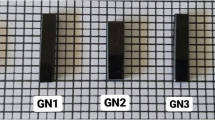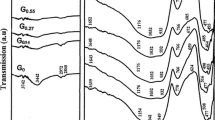Abstract
The ac electrical properties of some lithium silicate glasses and glass-ceramics containing varying proportions of Y2O3 and/or Fe2O3 were measured to investigate their electronic hopping mechanism. There is a clear variation of these properties with composition. The obtained results were related to the concentration and role of Y2O3 and/or Fe2O3 in the lithium silicate glass structure. In crystalline solids the electrical properties data obtained were correlated to the type and content of the mineral phases formed as indicated by X-ray diffraction analysis (XRD).
The conductivity, dielectric constant and dielectric loss of the studied glasses were studied using the frequency response in the interval 30 Hz–100 KHz and the effect of compositional changes on the measured properties was investigated. The measurements revealed that the electrical responses of the samples were different and complex. The addition of Y2O3 generally, decreased the ac conductivity, dielectric constant and dielectric losses of the lithium silicate glasses. The addition of Fe2O3 in Y2O3-containing glasses increases the conductivity, while, the dielectric constant and dielectric losses were found to be decreased. However, the addition of Fe2O3 instead of Y2O3 led to decrease the ac conductivity and increased their dielectric constant and dielectric losses.
The obtained data were argued to the internal structure of the lithium silicate glass and the nature or role-played by weakness or rigidity of the structure of the sample.
Lithium disilicate-Li2Si2O5, lithium metasilicate-Li2SiO3, two forms of yttrium silicate Y2Si2O7 & Y2SiO5, iron yttrium oxide-YFeO3, lithium iron silicate-LiFeSi2O6 and α-quartz phases were mostly developed in the crystallized glasses.
The conductivity of the crystalline materials was found to be relatively lower than those of the glass. At low frequency, as the Y2O3 content increased the ac conductivity, dielectric constant and dielectric loss data of the glass-ceramics decreased. However, the addition of Fe2O3 to the Y2O3 containing glass-ceramic led to increase the conductivity. The addition of high content of Fe2O3 instead of Y2O3 in the glass ceramic led to increase the ac conductivity.










Similar content being viewed by others
References
M.M. Gomaa, S.A. Hussain, E.A. El- Diwany, A.E. Bayoumi, M. Ghobashy, Presented at the 69th Annual International Meeting: Society of Exploration Geophysics (SEG) and International Exposition, Session “Borehole/Rock Physics characterization of rock and fluid properties”, Oral PHRP7, Oct. 31–Nov. 5 (Houston, Texas, 1999) 204–207
P.N. Sen, C. Scala, M.H. Cohen, Geophys. 46(5), 781–795 (1981)
W.E. Kenyon, J. Applied Phys. 55, 3153–3159 (1984)
R. Knight, A. Nur, Geophys. 52(5), 644–654 (1987)
P.W. McMillan, Glass-ceramics (Academic Press, London, N.Y., 1979)
E. Haslund, B.D. Hansen, R. Hilfer, B.J. Nost, J. Appl. Phys., 76, 5473–5480 (1994)
B. Nettelblad, G.A. Niklasson, J. Phys.: Condens. Matter, 8, 2781–2790 (1996)
M.B. Volf, Mathematical approach to glass, glass science and technology, vol. 9 (Elsevier Science Publishing Co., Inc., New York, 1988)
J.D. Mackenzie, J. Am. Ceram. Soc. 47(5), 211–214 (1964)
K.W. Hansen, M.T. Splann, J. Electrochem. Soc. 113(9), 895–899 (1966)
L.A. Grechanik, E.A. Fainberg, I.N. Zertsalova, Sov. Phys.-Solid State (Engl. Transl.) 4(2), 331–333 (1962)
G.O. Karapetyan, V.A. Tsekhomskii, D.M. Yudin, Sov. Phys.-Solid State (Engl. Transl.) 5(2), 456–460 (1963)
J. Wong, C.A. Angell, Glass structure by spectroscopy (Marcel Dekker, New York, 1967)
H. Darwish, M.M. Gomaa, J. Mater. Sci.: Mater. Electron. 17(1), 35–42 (2006)
M.A. Kanehisa, J. Non-Cryst. Solids 151, 155–159 (1992)
S.N. Salama, Z.S. El-Mandouh, Bull. NRC, Egypt 18(3), 211–224 (1993)
L. L. Hench H.F. Shaake, in Introduction to glass science, ed. by L.D. Pye and Co. (Plenum Press, New York, 1972), p. 583
A.M. Nasser, S.S.H. Gomaa, S.M. Salman, F. Mostafa, Glass and Ceramic Bull. 30(3), 62 (1983)
K. Zirkelbach, R. Breuckner, Glastech. Ber. 61(1), 12 (1988)
V.N. Kondrative, Bond dissociation energies, ionization potentials and electron affinities (Manka, Moscow, 1974)
O.H. El-Bayoumi, R.K MacCrone, J. Am. Ceram. Soc. 59(9–10), 386–391 (1976)
M. EL-Desoky, J. Phys. Chem. Solids 59(9), 1659–1666 (1998)
A.A Zaky, R. Hawley, Dielectric solid, (Routledge and Kegan Paul Ltd, London, 1970), p. 37
H.K. Patel, S.W. Martin, Phys. Rev. B, 45, 10292–10300 (1992)
P. Balaya, V.K. Shrikhande, G.P. Kothiyal, P.S. Goyal, Curr. Sci. 86(4), 553–556 (2004)
C.I. Merzbacher, W.B. White, J. Non-Cryst. Solids 130, 18–34 (1991)
Y. Kato, H. Yamazaky, M. Tomozawa, J. Am. Ceram. Soc. 84(9), 2111–2116 (2001)
S. Fujita, Y. Kato, M. Tomozawa, J. Non-Cryst. Solids 328, 64–70 (2003)
R.A.B. Devine, J. Non-Cryst. Solids 152, 50 (1993)
M. Rokita, M. Hanke, W. Mozgawa, J. Mol. Struct. 511/512, 277–280 (1999)
E.I. Kamitsos, M.A. Karakassides, G.D. Chryssikos, J. Phys. Chem. 91(22), 5807–5813 (1987)
K. El-Egili, Physica B 325, 340–348 (2003)
M.A. Villegas, J.M. Fernandez Navarro, J. Non-Cryst. Solids 100(1–3), 453–460 (1988)
Z. Strnad, Glass-ceramics materials, in glass science and technology, vol. 8 (Elsevier, Amsterdam, The Netherlands, 1986), pp. 185–252
A.P. Barranco, F.C. Pinar, O.P. Martinez, J.S. Guerra, I. Carmenate, J. Euro. Ceram. Soc. 19, 2677–2683 (1999)
L. L. Hench, S.W. Freiman, D.L. Kinser, Phys. Chem. Glasses, 12, 58 (1971)
S.N. Salama, S.M. Salman, Ceramugia XVII(3/4),122 (1987)
Author information
Authors and Affiliations
Corresponding author
Rights and permissions
About this article
Cite this article
Gomaa, M.M., Darwish, H. & Salman, S.M. Electrical properties of some Y2O3 and/or Fe2O3-containing lithium silicate glasses and glass-ceramics. J Mater Sci: Mater Electron 19, 5–15 (2008). https://doi.org/10.1007/s10854-007-9288-3
Received:
Accepted:
Published:
Issue Date:
DOI: https://doi.org/10.1007/s10854-007-9288-3




